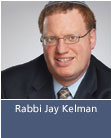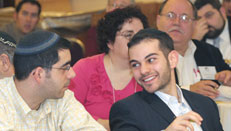 |
||||||||||||
| Weekly Parsha | ||
| Current Week | ||
| Parsha Archives | ||
| Business Ethics | ||
| Dr. Malamet Speaks Out | ||
| TiM MP3 Library | ||




A Thought for the Week with Rabbi Jay Kelman |
 The Jewish holidays have two distinct themes. The three pilgrim festivals ( shalosh regalim) of Pesach, Shavuot and Sukkot, occurring at key agricultural seasons, are a time to reflect on our material blessings, specifically in the land of Israel . Concurrently, these same holidays commemorate the formative historical events in the founding of our nation, affording an opportunity to reflect on the mission of the Jewish people. Rosh Hashanah and Yom Kippur, on the other hand, focus not on national events but on our individual relationships with G-d. They are a time for personal introspection and teshuva . These two sets of holidays each have their distinct moods. The shalosh regalim are times of joy and celebration. Rosh Hashanah and Yom Kippur, with their focus on "who shall live and who shall die", are suffused with fear and trepidation. While they too are Yamim Tovim, they are, in the words of Rambam (Hilchot Chanuka 3:6), devoid of simcha yeteira , excessive joy; and hence Hallel, the songs of praise are not recited. In medieval times many had the custom to fast during the day of Rosh Hashanah; it was almost equated with Yom Kippur. After all, how can one eat on the Day of Judgment? This division of the holidays into two thematic components is logical but paints an incomplete picture. There are actually six Biblical holidays. Shmini Atzeret, our Sages (Sukkah 47a) note, is a " regel bfnei atzmo ", an independent holiday. At first glance Shmini Atzeret appears to be part of the shalosh regalim model, with the Torah appending it as the eighth and "concluding day" of Sukkot. Yet there is more to it than meets the eye. Though often unnoticed, an examination of the sacrifices brought on each holiday subtly paints a more nuanced picture. On Pesach and Shavuot the additional offering ( korban mussaf ) consists of two bulls, one ram and seven sheep (and a goat for a sin offering). On Rosh Hashanah, Yom Kippur and Shmini Atzeret, the Mussaf offering consists of one bull along with one ram and seven sheep (and a goat for a sin offering). The Torah apparently wants to link Shmini Atzeret with the days of awe of Rosh Hashanah and Yom Kippur. This blurring of the line between joy and awe actually begins during Sukkot itself. Sukkot is not just one of the three pilgrim festivals but is also part of the chagei Tishrei , the natural continuation of Rosh Hashanah and Yom Kippur. While Sukkot is zman simchateinu , the time of our joy, it is also a time of hoshanot , of calling out to G-d to "save us". It is the time chosen to read Kohelet, with its depressing message of futility. On Hoshanah Rabba we encircle the bimah seven times as we beseech G-d to save us. The High Holiday tune is used for davening and the chazan wears a kittel reminding us of the day of death. According to the Zohar, it is on Hoshanna Rabba and not Yom Kippur that our judgment is finally sealed. Interestingly, the korbanot mussaf on Sukkot are doubled; two rams, 14 sheep (and its separate calculation of bulls) indicating the dual nature of Sukkot-it is both the third pilgrim festival and the last of the High Holidays. There is great joy but there is also great fear. While a Jew should strive to always be in a state of Simcha, our tradition is weary of too much simcha , fearing it could and would lead to frivolity. So much so that the Rabbis instituted three (yes, three) fast days of BeHaB , complete with selichot, during the week following Pesach and Sukkot, to atone for misplaced simcha . (Shavuot, lasting only one day, apparently presented no such fear). Before we can begin zman simchateinu we must experience the serious introspection of the Yamim Noraim . After seven days of Sukkot we are to be ready for Shmini Atzeret , where the focus is only on joy. Our rabbis (Sukkah 48a) note the Biblical expression " vhayeta ach sameach" , and you shall be only happy (Devarim 16:15) is a reference to Shmini Atzeret . There is no lulav, sukkah, hoshanot , nothing save for simcha . It is no coincidence that it was this holiday that was chosen to be the one on which we complete the Torah. The ultimate goal of all the holidays is to reach a state of pure joy. That joy requires work; one must realize that joy is a serious matter and is enhanced by the recognition that G-d controls life and death. By combining the joy with awe we are able to reach the state of "only joy". Complete simcha can only be celebrated in the land of Israel . We in the Diaspora celebrate Shmini Atzeret for two days, the first day being much more solemn, with yizkor and the prayer for rain. The second day, what today we call Simchat Torah , is the day of joy where hoshanot are turned into hakafot . Only in the land of Israel, the land where the presence of G-d is most manifest, can we have the complete culmination of the holiday season: a day when awe is turned into joy, and we celebrate our most precious gift, the gift of Torah.! |
|
|

 |
 |